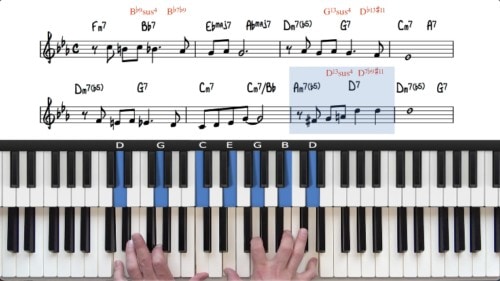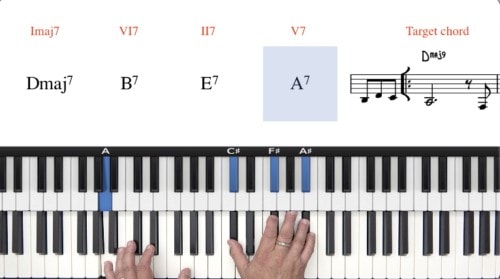Gospel Chord Progressions
In this lesson we explore a range of gospel chord progressions that can be used for introductions to gospel songs, church services, and also in jazz and blues music.
Gospel introductions set the mood for the whole performance and well-crafted introductions lead smoothly into the 1st chord of the song to set up the vocalist or church choir.
Gospel Chord Progressions & Formulas
There are a potentially infinite number of ways to play a gospel piano introduction. In this lesson we examine some of the most common gospel chord progressions that are used for introductions in churches and for solo piano performance.
These gospel chord progressions include many stylistic elements of gospel piano playing such as walk ups, walk downs, sus chords, passing chords, and turnarounds.
The first example contains the 2, 4, and 5 chords and then moves into a turnaround. We introduce the concept of ‘gospel walk up chord progressions’ which is further developed in the next examples.
36251 Gospel Chord Progressions
The 36251 is a common progression found in most styles of improvised music. When playing gospel piano it’s common to play most of the chords in the 36251 progression as a string of dominant chords. In the following example, 3 of the 5 chords are voiced as dominant chords:

It’s important to understand the construction of this common gospel chord progression. If the 36251 progression is new to you, check out the related lessons below.
Gospel Walk Up Chord Progressions
When playing chord progressions in a gospel style we can use ‘walk ups’ in our bass line to accentuate the chord changes and add more interest into the lower registers of our playing.

It’s common to walk up from the II chord to the IV chord, or from the II chord to the V chord. We also discuss walk ups over a plagal cadence for example D7sus to D7. This walk up is used to accentuate a leading tone which we discuss in the next lesson.
Gospel Walk Down Chord Progressions
Just as we can walk up with our bass lines we can also walk down. In the demonstrations we walk up and down in the same gospel chord progression using octave bass lines and also creating a moving bass line from the root of the chords that we are playing.
Sus Chords, Plagal Cadences, & Tritone Substitutes
All of the chords in this progression can be played as sus chords to create additional interest and movement. The V7 chord and the VI7 chord are particularly good candidates to apply sus voicings.
We can experiment with plagal cadences & tritone substitution to open up more creative ways to play these simple 36251 gospel chord progressions.
A plagal cadence movement could be for example D7sus to D7. The other option is to move from D7sus to the tritone Ab7 which creates a chromatic approach into the G7 chord. Study the examples in the lesson.
Lesson Downloads
Gospel Chord Progressions

Gospel Chord Progressions
Get a beautifully notated 3-page PDF packed with lush gospel chord progressions. Print and play today!
Practice Tips
-
All of the introductions are demonstrated in the key of F and they all end on the V7 chord. Keep that 'end point' in mind when transposing these gospel chord progressions into other keys.
-
Many hymns and church songs start on the tonic. The V7 chord is the final chord of our intro which leads us into the song smoothly and convincingly with a V to I resolution.
-
Adding alterations to the final V7 chord builds extra tension and a stronger sense of resolution into the first chord of the tune.
-
Experiment with the walk up and walk downs to get more authentic sounding gospel chord progressions. Walking up from the II to the IV chord, or the II to the V chord is a common movement in gospel piano.
- Introduce sus voicings into your progressions as directed in the tutorial.







Wow… watching the gospel lessons is so addicting. My jaw just dropped! Incredible lessons. Thank you so much! – Kristeta
realised I have a question pls :) bar 5 – how do we work on the pedal there while playing those chords? thanks so much!! it did create a really nice effect during that bar – something to do with the pedal maybe :D